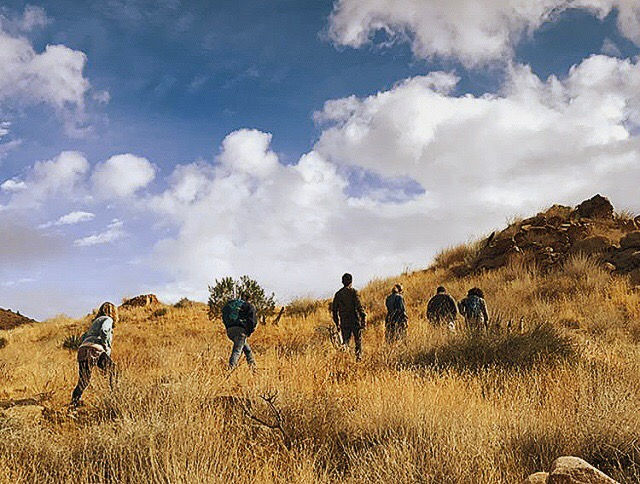TO WILDCRAFT OR NOT TO WILDCRAFT... Interview with The Practical Herbalist.
- Christina Every Leaf Speaks Botanical Studies
- Apr 25, 2019
- 4 min read
Howie Brounstein founder of Columbines School of Botanical Studies in Eugene, Oregon and I visited with our friends of The Practical Herbalist at their studios for their podcast, Real Herbalism Radio and chatted about a wildcrafting. (WILDCRAFTING WITH HOWIE BROUNSTEIN AND CHRISTINA SANCHEZ)

This is a topic that has me thinking seriously of the impact that ecosystems are inquiring as herbalism is becoming more and more popular and as this happens there are more folks wildcrafting plants. I have seen in recent times more folks with no herbal training asking me to teach them wildcrafting, don't worry I do not teach wildcrafting. Many of these folks have no knowledge of the land much less the plants, having perhaps taking a online course or a couple of workshops on herbal preparations, plant walks going out there and wildcrafting, especially in the desert where I live. These folks are turning around to create plant based products, blasting it all over social media. Many of them are gathering the wrong plants and listing it to be what they thought it to be. So they are taking the wrong flora and are making herbal products, this is beyond scary and extremely unethical and non-sustainable. I forgot to mention that these folks are labeling their products as "SUSTAINABLY or ETHICALLY WILDCRAFTED". This is a phrase that is being loosely used and as the trend of wildcrafting is rising, the land and flora along with the critters are impacted by these folks. I elaborate a bit more on it in this video and podcast interview with REAL HERBALISM RADIO.
As desert flora are becoming more popular and more folks are seeking the medicines of the desert we need to consider that this ecosystem is not like that of the PNW. Things don't bounce back and the land is not in abundance of water. So when gathering, our actions are impacting not only the plant but the critters that seek the flora for food and shelter. There are many times when I don't pick because it is not the right time or my actions can have a negative impact. So we need to learn to check ourselves to ensure the continuance of these flora.

When I see these products and post by folks who say they are ethical and sustainable, it brings questions to mind for me. Are these folks experienced and knowledgeable of the plants? Are they tending to the land, are they revisiting the stands they gather from to see if their wildcrafting has had an impact on the plants and the land? Where are they gathering? Is it on protected lands, parks, etc? How much are they gathering and what time of year are they gathering? Are they gathering from contaminated free areas? Do they have the proper tools to gather? Are they properly identifying the plants? These are just a few things that come to mind.

It is evident of the lack of expertise and knowledge when I find folks say they"ethically" wildcraft plants that they have posted photos of on Instagram and it turns out to be the wrong plant or they are wildcrafting plants like White Sage which is a plant that is not only impacted by commerce but environmental factors have impacted the plant community. I have gotten into conversations with folks defensive of their products because they say the stand they go to is thriving and they have a personal relationship with it. Well, here I find issue with these folks. Just because that one location they pick from is healthy does not speak for the entire species. The overall community of White Sage Salvia apiana has dwindled as many other defensive poachers are also claiming to be ethical, pick from healthy stands adding in the drought and how this plant responds to fire. Fire suppression has also impacted stands. Though White Sage is not listed on state or federal as threatened or endangered it is listed on the United Plant Savers list of plants "TO WATCH" United Plant Savers is an organization founded by Rosemary Gladstar that looks out for the plants that are impacted by commerce. White Sage only grows in Southern California and in Northern Baja California. The demand of this plant has reached to folks not only in the states but internationally, for use of burning. Claims made by others stating that it will clear bad energy, uplift the vibes, ground, etc etc have folks all over sourcing for White Sage. THERE IS NOT ENOUGH WHITE SAGE TO FILL THIS DEMAND. Use other aromatics like Lavender, Thyme, Rosemary to name a few or GROW YOUR OWN WHITE SAGE.
Let's protect the plants. We can do our part by STOP supporting those who are wildcrafting White Sage for plant based products, no matter how large of a company or small. Juniper Ridge is a prime example of a group of poaching folks especially the founder, Hall Newbigan who has herbal training with Michael Moore (the herbalist) and is out there with his crew of poachers impacting plant communities for their products. When you find White Sage bundles or based products as the shop owner if they know where the plants are being gathered? Is it wild or cultivated? If you feel confident in approaching them, uses this opportunity to educate and not attack. My partner spoke on White Sage conservation at Cactus Mart in Morongo Valley in the Mojave Desert in December and we were shocked by the amount of folks in attendance who were unaware of the current status. So many folks don't know and a little kindness can change their minds.
Companies who are growing their own White Sage are Oshala Farm, Sage Wind Farms.
















Comments